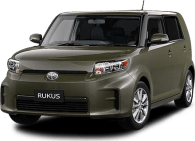It’s easy to get lost in the endless stream of new and updated mid-size SUVs, but the good news is that, in Australia’s highly competitive market, it means there's a long list of very good choices.
One of those choices is this; the freshly updated Kia Sportage range for the 2020 model year. You’re probably thinking that it looks exactly the same as last year’s model, and you’d be right. The changes to the Sportage are small and largely invisible, but they do add up to this particular variant being our pick of the range.
So, what’s new and why is this mid-grade Sportage the best one? Read on to find out.
.jpg)
Kia Sportage 2020: SX (fwd)
| Safety Rating |
|
|---|---|
| Engine Type | Inline 4, 2.0L |
| Fuel Type | Unleaded Petrol |
| Fuel Efficiency | 7.9L/100km (combined) |
| Seating | 5 |
| Price From | $22,990 - $28,380 |
Does it represent good value for the price? What features does it come with?
8 / 10
The SX is the lower mid-grade in the Sportage range (once known as the Si Premium). Coming in at $32,490 as a petrol automatic, it faces tough competition in this segment against notable rivals like the Toyota RAV4 GX ($31,640), Subaru Forester 2.5i ($33,840), and Honda CR-V VTi-S ($33,290).
.jpg)
While those cars have their advantages over the Sportage in certain categories, the SX you’re looking at here comes with the best Sportage equipment at the most reasonable price.
Included are 18-inch alloy wheels, LED DRLs (but just halogen headlights), leather-trimmed wheel and shift-lever, hard-wearing cloth seat trim, a 3.5-inch dot-matrix info screen in the dash, an 8.0-inch multimedia touchscreen with Apple CarPlay and Android Auto support, DAB+ digital radio, built-in sat-nav, eight-speaker JBL audio system, dual-zone climate control, as well as front and rear parking sensors and reversing camera. One letdown at this price point is the fact that the SX gets no keyless entry, or push-start ignition.
.jpg)
To get features like that, as well as leather seats, you’ll have to make a $7,000 spec jump to the SX plus. A jump we’d argue isn’t worth it, considering you’ll still be getting a front-wheel-drive, petrol-engined Sportage.
On that topic, you’re able to have the SX as seen here as an all-wheel-drive diesel at $39,490 (another whopping $7,000 jump). If you’re really after all-wheel drive, the Subaru Forester is the most cost-effective option, or you can even have it on the Toyota RAV4 GX for a little extra.
The active-safety front is at least halfway decent from the base Sportage up. Key items are included, but there are issues here too, which we’ll explore in the safety section of this review.
Is there anything interesting about its design?
8 / 10
The Sportage has aged well, largely due to its bold design, which some might even consider controversial.
.jpg)
With the light clusters mounted atop the bonnet, the strip-light across the rear and its bulbous styling, it’s hard not to see the Porsche Cayenne influence on the Sportage’s look. The side profile is stocky, almost that of a giant hatchback, with a chunky but confident outline. I’m not usually a fan of chrome fittings, but the Sportage has at least tastefully applied them around its window fittings and in the grille.
.jpg)
If it’s a more traditional SUV look you’re after, you can always consider the Hyundai Tucson, with which the Sportage shares a platform.
It’s genuinely hard to tell most Sportage variants apart from each other, and none of them scream ‘poverty pack,’ which is a very good thing for buyers at this end of the price scale.
The interior has also stood the test of time comparatively well, thanks to a slick design out of the box. There are some touches that don’t follow current interior trends – the multimedia touchscreen is embedded in the dash, rather than extruded tablet-style, and there’s an abundance of shortcut buttons smattered across the lower dash. Thankfully, these are rather useful.
.jpg)
A leather-trimmed wheel and gearknob are welcome touches, and the aesthetic of the dash is tasteful, but sedate, being comprised of mostly plastics in similar shades of grey.
One thing that stands out about the Sportage’s cabin is how solidly built everything is. There’s not a creak to be heard, and despite some less-than-impressive-plastics on the lower half of the dash, the fit and finish is excellent.
One element of the asymmetrical layout I liked was the driver’s side cutaway on the centre console – it leaves plenty of room for your knee.
The Sportage’s overall aesthetic might not be for everyone, but its design does make for a nice balance of forward-thinking looks and practicality, as explored in the next segment of this review.

How practical is the space inside?
8 / 10
As with most other Kia products, the interior design of the Sportage is full of practical stowage areas and other bonuses for cabin occupants.
Up front there’s a set of nicely sized cupholders in the centre console and door cards, a massive storage trench in the cutaway underneath the climate controls, a centre-console box that’s twice the size of the one in the Tucson, and a glovebox. Those spaces are complemented by a generally spacious cabin area for both front occupants. There are also vanity mirrors with lights for both seats.
In the rear seat the legroom is more than enough behind my own driving position (I’m 182cm tall) but not the most in the class, while the seat trim is comfortable and headroom is plentiful. There are pockets on the back of both seats, decently sized bottle holders in the doors, a drop-down armrest with smaller bottle-holders, and – unlike its Tucson cousin – rear air vents and dual power outlets.
.jpg)
The rear doors on the Sportage are huge, allowing for easy access to the back seat, or ease of fitting a child seat. The back seats can be reclined for extra passenger room or luggage space as required.
On the topic of luggage space, the Sportage has a 466-litre boot. For context, it’s at the lower end of the mid-size SUV spectrum, on-par with its Tucson (488L) cousin but eclipsed by other major competitors like the Nissan X-Trail (522L), Toyota RAV4 (580L), and even its incoming Korean rival, the new-generation Ssangyong Korando (551L).
Part of the reduction in boot space over major rivals is down to the high boot floor, which is necessary to facilitate the full-size alloy spare – a huge bonus for regional buyers.
.jpg)
What are the key stats for the engine and transmission?
7 / 10
Most of the Sportage range makes use of an older 2.0-litre multi-point injected four-cylinder petrol engine. Power figures are par-for-the course in the segment at 114kW/192Nm.
Its Tucson cousin gets a more modern version of the same engine (thankfully with direct injection), but it would be nice to see a higher-tech turbocharged option like the 1.5-litre engine that appears in the Honda CR-V.
.jpg)
All 2.0L petrol versions of the Sportage drive the front wheels via a six-speed torque converter automatic, which is better than CVT rivals for driving feel but worse for fuel consumption.
A 2.0-litre turbo diesel engine with all-wheel drive and an eight-speed automatic transmission (136kW/400Nm) can be optioned on the SX at a $7000 premium.
How much fuel does it consume?
6 / 10
After testing many versions of the Sportage in the weeks surrounding this review, I was consistently disappointed with the fuel consumption offered by the petrol engine.
.jpg)
The claimed/combined fuel-consumption figure is 7.9L/100km, but the fine-print reveals a far more accurate “urban” fuel estimate of 10.5L/100km. My week-long road test over almost 400km returned a figure of 10.9L/100km. Before you ask – yes, I did mix my usage, hitting the freeways off-peak for several days as part of my testing.
On the upswing, the simple engine technology allows owners to fill the Sportage’s 62-litre tank with base-grade 91RON unleaded.
Warranty & Safety Rating
What safety equipment is fitted? What safety rating?
7 / 10
The Sportage has a decent active-safety suite, although our overall score has dropped year-on-year thanks to competitors now offering more.
Standard across the entire range are auto emergency braking (AEB) with forward collision warning, lane-keep assist (LKAS), driver-attention alert (DAA), and high-beam assist.
.jpg)
One point of frustration is that most Sportage variants are stuck with the entry-level suite, you’ll have to spec your way all the way up to the flagship GT-Line to get the full suite, including blind-spot monitoring (BSM), rear cross traffic alert (RCTA), lane-change assist, and active cruise control.
It’s frustrating now that the new-generation Toyota RAV4, Subaru Forester, and Mazda CX-5 have more comprehensive safety offerings at lower prices.
All Kia Sportages have six airbags, the expected stability and brake controls and carry a maximum five-star ANCAP safety rating, as of 2016.
What does it cost to own? What warranty is offered?
9 / 10
Kia’s ownership promise continues to be up there amongst the best in the business, with a seven-year/unlimited-kilometre warranty, backed by eight years of roadside assist and seven years of capped-price servicing.
The drawback is servicing isn’t particularly cheap, averaging out to $391.71 per year for 2.0-litre petrol variants, like the one tested here.
If it’s a class-leading service promise you’re after, keep an eye out for the SsangYong Korando, which will offer a similar seven-year program when it arrives in Australia.
.jpg)
What's it like to drive?
8 / 10
Driving the Sportage is like driving a giant hatchback, and for the most part that’s a good thing. Kia provides all of its vehicles with an Australia-specific suspension tune, which is what really sets them apart from competitors.
On a recent comparison test, all agreed the Sportage even felt nicer behind the wheel – in terms of its ride, steering weight, and handling – than its Hyundai Tucson cousin, and overall it offers a firm but compliant ride when stacked up against segment rivals.
For a bit of context, the new Toyota RAV4 and Nissan X-Trail have much softer, more comfort-focused rides, whereas Mazda’s CX-5 and the Sporage’s Tucson cousin are on the stiffer, sportier side.
.jpg)
The Sportage, then, offers a balance that should be suited to most buyers.
On the topic of engines: the 2.0-litre petrol is not this SUV’s strongest suit. Its power figures are on par for the segment but mated to a six-speed auto it tends to be a bit thrashy (and fuel-thirsty) when pushed. This isn’t uncommon at this end of the mid-size SUV price scale, but Honda’s CR-V and Mazda’s CX-5 prove there are more modern, slicker drivetrains to be had if you look.
The six-speed auto, while not the best for fuel consumption compared to CVT rivals, offers more driving engagement for those so inclined.
Verdict
There’s so much to like about the Sportage SX, despite only minor changes for the 2020 model year. The petrol engine in particular is a weak link, but other than that the technology, practicality, and handling package on offer here should make it a compelling option for buyers shopping in the segment.
Most importantly, though, the SX is the most competitively priced of the entire Sportage range, offering the lion’s share of available spec items at a price on-par to or undercutting similar rivals.
Pricing Guides

Range and Specs
| Vehicle | Specs | Price* |
|---|---|---|
| S (fwd) | 2.0L, Unleaded Petrol, 6 SPEED AUTOMATIC | $20,900 - $26,510 |
| S (fwd) | 2.0L, Unleaded Petrol, 6 SPEED MANUAL | $19,580 - $24,750 |
| SX (fwd) | 2.0L, Unleaded Petrol, 6 SPEED AUTOMATIC | $22,990 - $28,380 |


.jpg)


.jpg)
.jpg)
.jpg)







.png)













.jpg)
.jpg)


.jpg)
.jpg)

Comments